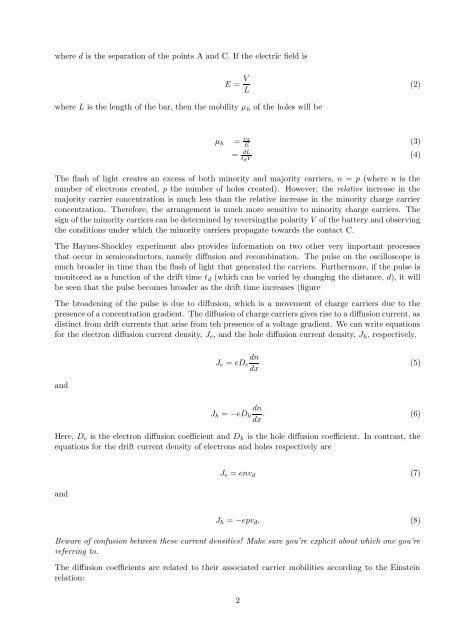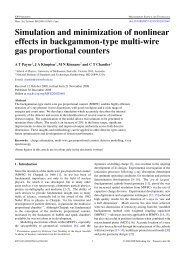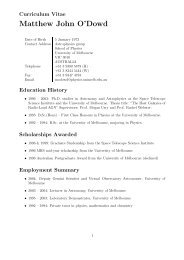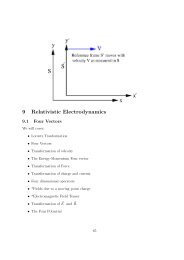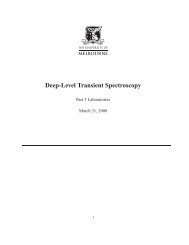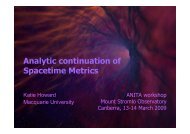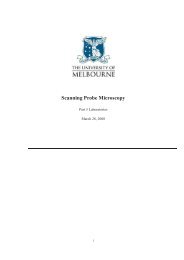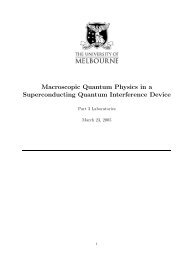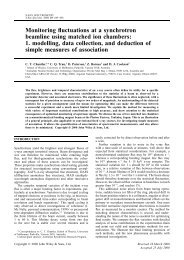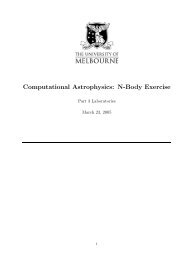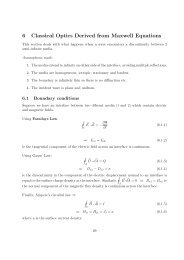1 Introduction 2 The Haynes-Shockley Experiment
1 Introduction 2 The Haynes-Shockley Experiment
1 Introduction 2 The Haynes-Shockley Experiment
Create successful ePaper yourself
Turn your PDF publications into a flip-book with our unique Google optimized e-Paper software.
where d is the separation of the points A and C. If the electric field is<br />
E = V L<br />
(2)<br />
where L is the length of the bar, then the mobility µ h of the holes will be<br />
µ h = v d<br />
E<br />
(3)<br />
= dL<br />
t d V<br />
(4)<br />
<strong>The</strong> flash of light creates an excess of both minority and majority carriers, n = p (where n is the<br />
number of electrons created, p the number of holes created). However, the relative increase in the<br />
majority carrier concentration is much less than the relative increase in the minority charge carrier<br />
concentration. <strong>The</strong>refore, the arrangement is much more sensitive to minority charge carriers. <strong>The</strong><br />
sign of the minority carriers can be determined by reversingthe polarity V of the battery and observing<br />
the conditions under which the minority carriers propagate towards the contact C.<br />
<strong>The</strong> <strong>Haynes</strong>-<strong>Shockley</strong> experiment also provides information on two other very important processes<br />
that occur in semiconductors, namely diffusion and recombination. <strong>The</strong> pulse on the oscilloscope is<br />
much broader in time than the flash of light that generated the carriers. Furthermore, if the pulse is<br />
monitored as a function of the drift time t d (which can be varied by changing the distance, d), it will<br />
be seen that the pulse becomes broader as the drift time increases (figure<br />
<strong>The</strong> broadening of the pulse is due to diffusion, which is a movement of charge carriers due to the<br />
presence of a concentration gradient. <strong>The</strong> diffusion of charge carriers gives rise to a diffusion current, as<br />
distinct from drift currents that arise from teh presence of a voltage gradient. We can write equations<br />
for the electron diffusion current density, J e , and the hole diffusion current density, J h , respectively,<br />
J e = eD e<br />
dn<br />
dx<br />
(5)<br />
and<br />
J h = −eD h<br />
dn<br />
dx . (6)<br />
Here, D e is the electron diffusion coefficient and D h is the hole diffusion coefficient. In contrast, the<br />
equations for the drift current density of electrons and holes respectively are<br />
and<br />
J e = env d (7)<br />
J h = −epv d . (8)<br />
Beware of confusion between these current densities! Make sure you’re explicit about which one you’re<br />
referring to.<br />
<strong>The</strong> diffusion coefficients are related to their associated carrier mobilities according to the Einstein<br />
relation:<br />
2


